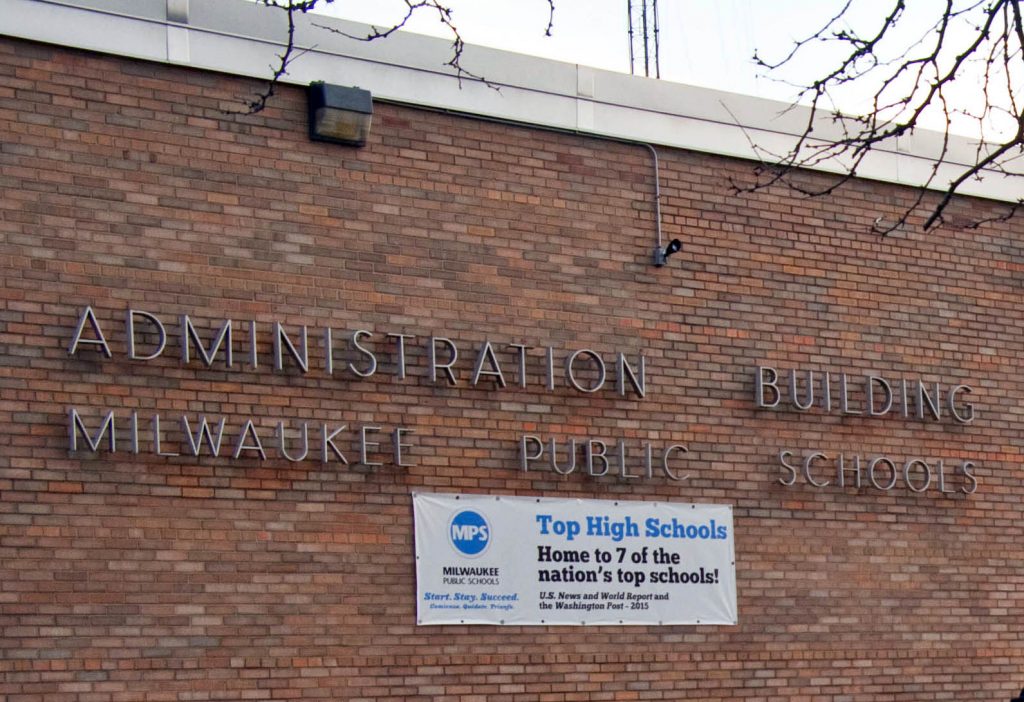Suspensions Up At MPS, With Steep Racial Disparities
Nearly 80% of those suspended are Black. Prior federal investigation found racial disparities.

Charles Edward Miller (CC-BY-SA)
Nearly 16,000 students have been suspended in Milwaukee Public Schools so far this school year, with Black students making up about 80% of the suspensions.
That’s compared to just 2.5% of suspensions for white students, according to data presented to the Milwaukee Board of School Directors this week.
About 14% of students who have been suspended so far this school year are Hispanic, according to MPS data.
Jon Jagemann, district discipline manager, said total suspensions in MPS are up 6.9% through February, or by about 900 total suspensions.
Those numbers could include students who have had more than one suspension, Jagemann said during Tuesday’s Committee on Parent and Community Engagement meeting.
Jagemann did not respond to further questions from WPR.
Administrators have given monthly suspension updates since September 2020, following an investigation by the U.S. Department of Education’s Office of Civil Rights that found MPS had disproportionately suspended or expelled Black students.
After Tuesday’s report, board member Henry Leonard asked for a “bird’s eye view of recidivism.”
He said that would give the board a better understanding of suspension rates.
“We’re not looking for names, we’re not looking to point out buildings, we’re looking to show how many students actually commit offenses that are suspendable,” Leonard said. “To give us a much better or clearer picture of what we’re really looking at.”
Long-term effects of suspensions unknown
Multiple studies have found suspensions are ineffective in most cases. Restorative justice practices, such as counseling or mediation, are more successful.
The American Institutes for Research studied exclusionary discipline, including suspensions, at New York City middle and high schools from 2009 to 2018. They found the punishments did not reduce misbehavior or result in improved academic achievement.
“But the results of our research, and related research on suspensions and the science of learning development, suggest these practices may be harming students’ long-term educational success and do not have a positive effect on the school community,” Osher said.
In MPS, suspension is a level 2 punishment, coming after a student has had a meeting with their teacher or administrator regarding their behavior.
A student can be suspended for physically harming another person, extortion, a false fire alarm, gambling, hazing, stealing or possessing a controlled substance, according to the student hand book.
Data from the district shows the majority of suspensions are in middle school and early high school, with seventh, eighth and 10th grade each having just over 2,000 suspensions. Ninth grade had the most students suspended at 4,162.
But the number of younger children being suspended has also risen, particularly in fourth and fifth grade.
About 100 children in both pre-kindergarten and first grade have been suspended.
Innovative strategies working at Roosevelt Middle School
Unlike the rest of the school district, suspensions are down 58% at Roosevelt Middle School, located in Milwaukee’s Brownsville community on the city’s north side.
Fighting incidents at the school are down 40% and disorderly conduct down 33%, according to Principal Tiffany Fisher.
Fisher said she has worked hard to turn around her school by using restorative justice methods.
A recent incident involved about a dozen girls who had an ongoing conflict with each other over social media outside of school that was seeping into the classroom.
“It could have easily yielded, with the repeat behaviors, about 10 suspensions,” Fisher said. “But we chose, with the help of our support staff, our trauma specialists and our assistant principal, to get all the parents to come in.”
The school even sent Ubers to homes where parents didn’t have transportation, to make sure everyone was involved.
The group worked with Running Rebels, a community organization that mentors youth. They sat in a circle and saw each other as humans instead of objectifying each other on social media, Fisher said.
Restorative circles, like the one the girls participated in are now scheduled twice a week for students.
“We do recognize that behaviors are escalating, that’s just the sign of the times, but we want them in school,” Fisher said. “We are the adults, we have to teach them. And we want to kind of stay ahead of the momentum.”
Suspensions up in Milwaukee Public Schools, racial disparities persist was originally published by Wisconsin Public Radio.
If you think stories like this are important, become a member of Urban Milwaukee and help support real, independent journalism. Plus you get some cool added benefits.






















And again the vast majority of these kids have been traumatized hence there socially unacceptable behavior which gets them suspended. It is the beginning of the School to Prison PIPELINE is it not. When will the powers to be at Urban Milwaukee begin to write a series of articles about how trauma impacts the BRAIN and HOW TO HEAL the brain??
Bruce Jeramey Data Wonk Will anyone respond and tell me WHY you are “religiously” refusing to address this issue??
Peace through the TRUTH
How many of the students suspended are dealing traumatic events in the home or neighborhood? Trauma interferes with learning as does food and housing insecurity. I find it very curious that suspensions are rising among 4th and 5th graders. That is when children begin to take on their adult appearance. I wonder how much of the suspensions are the result of behavior escalation caused by frightened teachers? Too much of that fear is related to unconscious racial stereotypes. Our local media too often contributes to the fear caused by these stereotypes.
Bottom line, this is a problem we all contribute to. We can’t continue to dump traumatized children into MPS (or any school for that matter) and then wag our collect fingers when they are unable to learn.
The “School to Prison Pipeline” that is often quoted is a myth that has been going unchallenged for decades. Having worked in juvenile corrections, I saw that the disruption behaviors often seen in school are a result of many different factors;. They just show up in school. Supporters of the “School to Prison Pipeline”myth imply that disruptive students are turned over to the police for minor infractions of school rules. Most all schools have programs to improve behavior of students who get suspended. When shopping centers have to call police because of disruptive behaviors young shoppers, I don’t hear persons saying that shopping centers are “Pipelines to Prisons”. I think that the students who come to school and follow the rules have a right to be in school as much as the disruptive students who sometime get suspended.
Is the Pipeline the issue or is the simple fact, as evidenced by the article, that there “disruptive students” in MPS. Trauma is part of the reason for the disruptive behavior. Then WHAT do those “disruptive students” NEED. Treatment for the trauma is a large part of that answer. Once “disruptive students” get the treatment they need to deal with the trauma that they have experienced the “pipeline” goes away.
Schools represent a very unique opportunity to help those kids who are traumatized and when the opportunity is missed some of those kids continues on the trajectory that ends with them being incarcerated at Lincoln Hills and the adult prisons of Wisconsin. Lots cheaper to provide therapy to 12 year old’s, than it is to incarcerated 16 year old’s who for the safety of the community must be incarcerated.
There is an expectation that schools are expected to deal with and treat all of the issues that their students bring to school. When these issues remain, schools are blamed for being derelict for not resolving all of the problems students bring to school. . Schools have devoted a significant amount of staff and resources to help students and not getting credit for the investments they have made. I always wonder all of the choice schools and those authorized by the City of Milwaukee are never held accountable for dealing with the needs of all of their students.
The Titanic had an two identical ship that were made the same way as the Titanic. Immediately after the sinking of the Titanic the obvious design failure was immediately corrected ie the open area at the top of each section that allowed the water from the hole in the ship to gradually fill the Titanic. They learned from there mistake and corrected it.
For school systems and education to KNOW that SOME children are traumatized and then NOT TO DEAL with the TRAUMA makes no sense.
It just happens that school is the one place where, the socially unacceptable behavior, is displayed and our choice is to SEE it and then provide the Therapy or we can continue to claim that it is not the School’s fault. CHANGE is critical to address the reality the facts that those students, whose brain’s have been injured by the traumas that they have experienced need therapy.
If there are blind students changes are made so they can continue to learn and likewise students who have been traumatized NEED/MUST HAVE changes made so they can continue to learn and all the other students can learn as well.
PS ALL students in all schools Public and Private must deal with ALL the students they have a DUTY to educate.